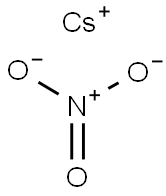Description
Cesium nitrate is a strong oxidizing material and may burst into flames when it is in contact with organic materials.
Cesium nitrate is used as a colorant and oxidizer in the pyrotechnic industry, in petroleum cracking, in scintillation counters, and in x-ray phosphors. It is used as a promoter in heterogeneous catalysts.
References
[1] Geological Survey (2014) Mineral Commodity Summaries
[2] http://www.albemarle-lithium.com
[3] https://minerals.usgs.gov
Chemical Properties
colourless crystals
Uses
Used in the synthesis of cesium nitratocuprate, Cs2[Cu(NO3)4], which crystallizes in a square-planar coordination around the Cu center.1
Uses
A reagent used as a colorant and an oxidizer in pyrotechnic compositions
Uses
Cesium nitrate prisms are used in infrared spectroscopy, x-ray phosphors and scintillation counters. It is a precursor material for the synthesis of cesium nitratocuprate and cesium salts. Cesium nitrate doped on carbon-based ruthenium catalyst plays an important role in synthesis of ammonia.
Uses
preparation of other Cs salts.
General Description
Cesium nitrate is a colorless, glittering crystalline solid. Cesium nitrate is soluble in water. Cesium nitrate is a strong oxidizing material and may burst into flames on contact with organic materials.
Air & Water Reactions
Water soluble.
Reactivity Profile
Mixtures of metal/nonmetal nitrates with alkyl esters may explode owing to the formation of alkyl nitrates. Mixtures a nitrate with phosphorus, tin (II) chloride, or other reducing agents may react explosively [Bretherick 1979 p. 108-109].
Hazard
Dangerous, may ignite organic materials on
contact.
Health Hazard
Inhalation, ingestion or contact (skin, eyes) with vapors or substance may cause severe injury, burns or death. Fire may produce irritating, corrosive and/or toxic gases. Runoff from fire control or dilution water may cause pollution.
Fire Hazard
These substances will accelerate burning when involved in a fire. Some may decompose explosively when heated or involved in a fire. May explode from heat or contamination. Some will react explosively with hydrocarbons (fuels). May ignite combustibles (wood, paper, oil, clothing, etc.). Containers may explode when heated. Runoff may create fire or explosion hazard.
Flammability and Explosibility
Non flammable
Safety Profile
Moderately toxic by
ingestion and intraperitoneal routes.
Mutation data reported. When heated to
decomposition it emits toxic fumes of NOx.
See also CESIUM and NITRATES.
Purification Methods
It crystallises from water (0.6mL/g) between 100o and 0o. After 1 crystallisation of 99.9% grade salt, it had K, Na and Se at 0.8, 0.4 and 0.2 ppm respectively.


